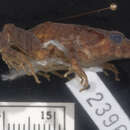Description
provided by AmphibiaWeb articles
Head is wider than body in males and immature females (when gravid, body cavity widens beyond lateral margins of head). Snout is short and subacuminate in dorsal view and rounded when viewed laterally. Nostrils are protuberant and directed laterally. Canthus rostralis is angular, concave. Loreal region is weakly concave and slopes abruptly to lips. The upper eyelids possess small pustular tubercles and have widths ranging from 100 to 135% interorbital distance (IOD) in males and 88-107.7% in females. Cranial crests are absent. The supratympanic fold is indistinct but obscures the upper edge of the tympanic annulus. Tympanic annulus is round in males and elongate vertically in females. Postrictal tubercles are subconical and are posterior to the tympanic annulus. Skin on head has many warts, including on the face, with those above the tympanic annulus being the most prominent. Dorsal skin is shagreen with large warts scattered about; the largest warts are found in areas of darker pigment. Some individuals had shorter ridges postsacrally made from the fusion of continuous warts. Flanks have more warts than the dorsum. Thenar tubercle is oval and much smaller than the bifid palmar tubercle. Supernumerary palmar tubercles are prominent, round, and smaller than the round nonconical subarticular tubercles. The first finger is shorter than the second. The disc on the thumb is not expanded whereas discs on fingers III and IV are approximately twice the width of the digits. All fingers have ventral pads defined by circumferential grooves. Fingers also possess narrow lateral fringes. In preservative, the dorsal coloration is brown with darker brown markings (chevrons, blotches, labial bars, canthal-supratympanic stripes); the cloaca is triangular and dark brown; belly and ventral surfaces of limbs cream with brown marbling. Pristimantis floridus belongs to the P. myersi group. Pristimantis floridus differs from all other species in the group in the following combination of characters: larger digital discs, color pattern, lacks dorsolateral folds, and has white mesorchial lining. Pristimantis leptolophus group members resembles P. floridus in the size of its digital discs, but the former are found in Colombia (members of that group also possess a fifth toe that is much longer than the third).
Distribution and Habitat
provided by AmphibiaWeb articles
Pristimantis floridus is only known from provincias Cotopaxi, Imbabura, and Pichincha in the western Andes at elevations ranging from 700-2000 m.
Life History, Abundance, Activity, and Special Behaviors
provided by AmphibiaWeb articles
Males lack nuptial pads.
Pristimantis floridus: Brief Summary
provided by wikipedia EN
Pristimantis floridus is a species of frog in the family Strabomantidae.
It is endemic to Ecuador. Its natural habitats are tropical moist lowland forests and moist montane forests. It is threatened by habitat loss.
- license
- cc-by-sa-3.0
- copyright
- Wikipedia authors and editors

